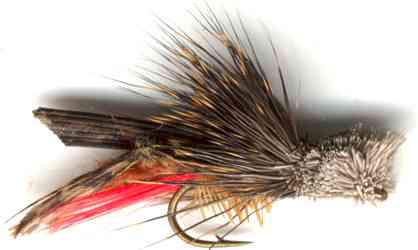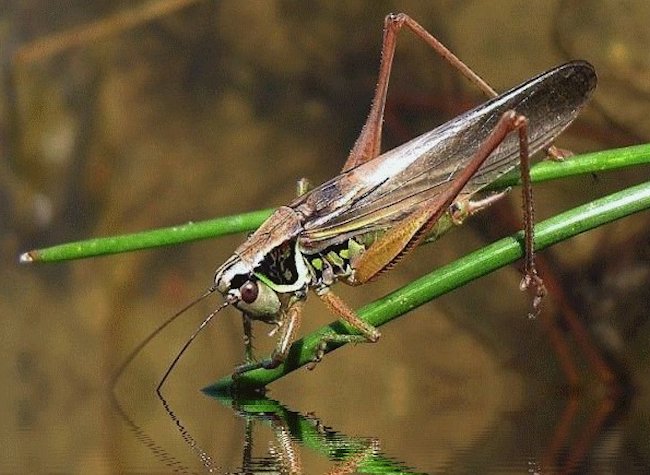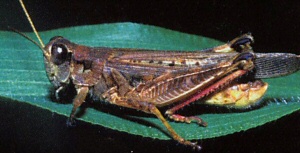Dave's Hopper Dry Fly
At certain time of year grasshoppers become abundant. This is when you should use a Dave's Hopper Dry Fly for Brown and Rainbow trout fishing. If you are in luck, a wind will blow these wonderful fish snacks into your favorite waters. It is then a great time to be a fly fisherman.

GRASS HOPPER AND CRICKET FLY PATTERNS. Hook size 12 - $US each
Dave Whitlock designed the Dave’s Hopper. Dave and Emily Whitlock live near Mountain Home, Arkansas, where they conduct the Whitlock Fly Fishing School. Fly fisherman Dave is an author, wildlife artist, world-renowned fly designer, and conservationist. Trout do not care if their food rises up from the stream bottom to hatch, or if it falls in from above. Trout pay close attention to the surface and this makes terrestrials an important food source. Anglers should not neglect flies that imitate terrestrial insects like grasshoppers, ants, crickets, beetles, leafhoppers, caterpillars, inch worms, spiders, snails. Terrestrials can make up more than 80% of a fish's diet at certain times of the year, especially in late summer and early fall. Grasshoppers survive well after the first frosts, although they are les vigorous, and hence more vulnerable. The will continue to catch fish in most places well into October.

A delicate presentation is not critical then because even big selective trout (largemouth or smallmouth bass, bluegill, etc.) are looking for the tell-tale splat of this helpless terrestrial as it flops into their eating zone. Second, these are big flies and you can use short leaders that are easy to cast. Moreover, even if a hopper has been chewed on a few times, the fish don't seem to mind. Grasshoppers can swim by kicking their hind legs in unison, using the same method as they employ when jumping. This is simply mimicked by fishing the fly on the surface and retrieving it with short sharp pulls. Continue for about three feet and then let your fly drift for 20 seconds before recommencing the retrieve. This imitates the grasshopper having a rest. Hoppers generally hatch from eggs in June and July and are full grown by mid-August. The adults continue to feed until the first frost. The eggs are laid under ground in late September and October. The best hopper fishing occurs in August and early September. They like hot weather, and you will find your best hopper fishing on hot windy afternoons. The only downside with hopper patterns is that they don't work all year round but keep some in your fly box just in case. Trout move into shallower riffles downwind from riverbanks near hayfields as the day warms up, on the lookout for helpless struggling grasshoppers locust and crickets. earlier in the day these fish will be hold up in deeper water, along seams. banks and drop offs. Once it gets warmer they return to the areas where they have feasted on these unlucky insects in the past.

Banks are the key to successfully fishing Hoppers. Most grasshoppers that find their way into the water's surface are concentrated in the foliage along the banks. Banks also provide cover and shade for fish during hot summer afternoons. Thus fish, which move to the banks for cover and shade, are putting themselves in the exact place where grasshoppers are most available. On large rivers, grasshoppers should be cast as close to the banks as possible. This is more important in streams where banks are slightly undercut and where vegetation hangs out over the water. On small streams, trout often see grasshoppers all across the water and will be willing to take an imitation in the middle of the stream. I was fishing on a small river in the French Alps last summer. There were fields either side of the river but the banks were wooded. I was surrounded by breath taking views of snow covered mountains. The sun was out and it was a perfect day. The early morning hatch had finished and takes were getting harder and harder as the fish started to hide from the midday sun. I noticed some light green grass hoppers jumping from rock to rock. Some missed and floated in the water, struggling against the current. Then there was a sudden splash. A trout had struck and successfully gained a large nourishing meal. One of these struggling creatures passed near my boot. I scooped it up from the water and put him on the bank where he could dry. This idiotic insect, with a death wish, jumped straight back into the river instead of the relative safety of the woods and fields. I observed that trout would move from their midday resting place to attack a grass hopper floating in the surface film where as they would not move for a standard mayfly pattern. Trout know that grass hoppers are a very substantial meal compared with a mayfly and therefore consider them worth the effort and energy of an attack.
Trout rise to the surface during rain storms. The extra disturbance on the water oxygenates the upper layers and cools the water temperature to a more pleasant fish friendly environment. They feel safer as choppy water makes them invisible to birds of prey. The falling rain beats down flying insects and forces them onto and under the water surface. Heavy rain also washes terrestrial insects into the water from the land, overhanging trees and shrubs. Summer storms are primetime for subsurface fishing. When the all the fair-weather fishermen are hiding under trees, in fishing huts or in their cars to keep dry, you will reap the rewards of some exciting fishing if you stay out in the rain. Just cast out your fly and let the rain drown it, just like what is happening to the real insects. Do not add any floatant. It is best to cast frequently as you will cover more water and I have found that the fly is normally taken just after it has broken the water surface. Fishing in heavy rain is an ideal time to try out new patterns . Trout have learned to expect a variety of different foods, not normally available to them, washed into the lake or river from various sources. They have learned to expect this yummy bounty when the skies darken and the heavy rain drops pound the water surface. Drowned Daddy Longlegs, Hoppers, Ants, Wet flies and soft hackle north country Spiders are my choice on rainy days.
CUSTOMER'S COMMENT
I have just come back from a fantastic days fishing on the Llyn Trawsfynydd. It lies within the shelter of the Snowdonian mountain range in Wales. You quite often see film crews up here filming period dramas it is such a pretty location. It fishes well to flies near the surface. I used a beaded hackled pheasant tail on point, a Diawl Bach nymph on the middle dropper. As a strike indicator I tied on one of your Dave’s hoppers. I caught five fish and they all took my hopper much to my surprise. Connor O'Brian
LINKEDIN COMMENT
What flies work best for Cutthroat Trout? - Yes, hopper patterns are Killer from late August into October. - By Mark Greer
LINKEDIN COMMENT
What flies work best for Cutthroat Trout? - On the Lamar in Yellowstone one October I walked down the center of the shallow river and cast a hopper to the edges. Cuttys of about 16-18 inches pounded my fly until it was in tatters. - By Jim Ure
LINKEDIN COMMENT
What flies work best for Cutthroat Trout? - Here in the west there is nothing like hoppers in August. By Steve Heinitz, USA
Fly Fishing books



